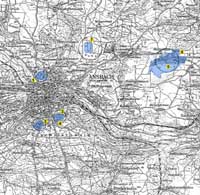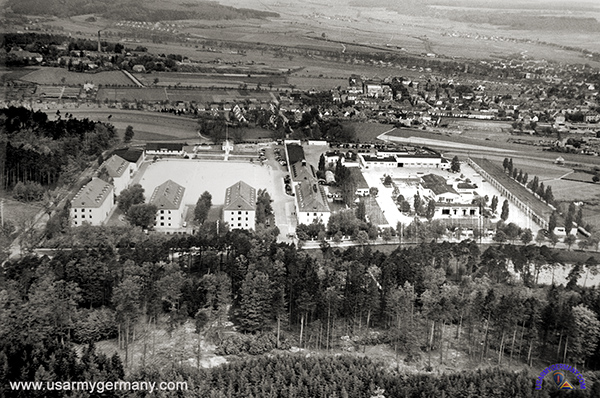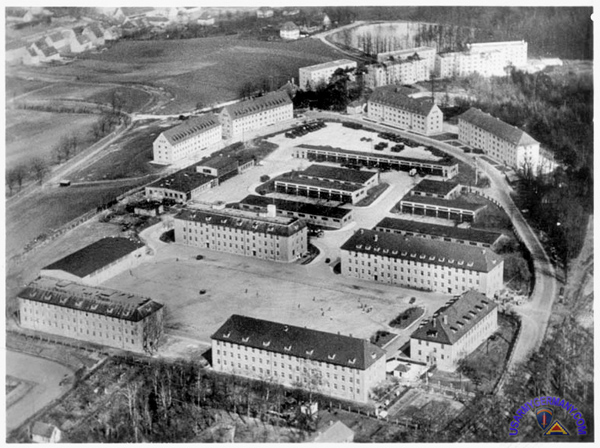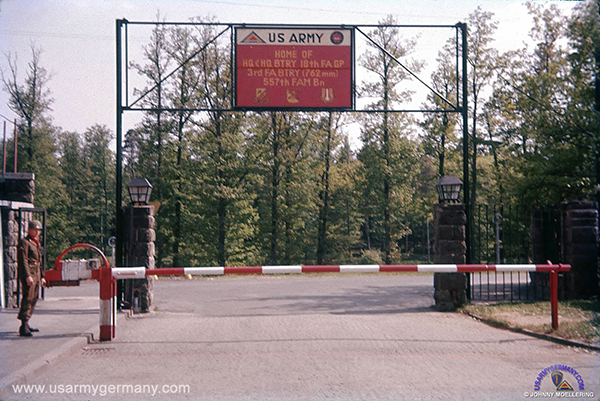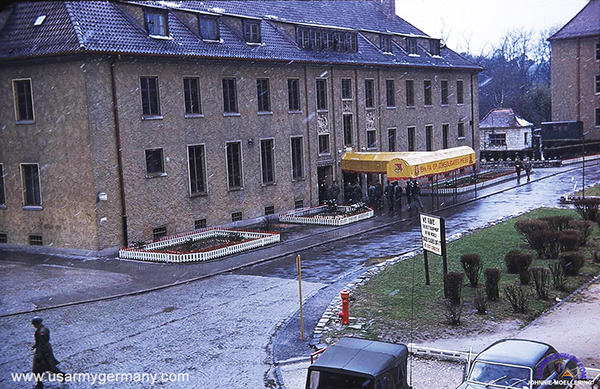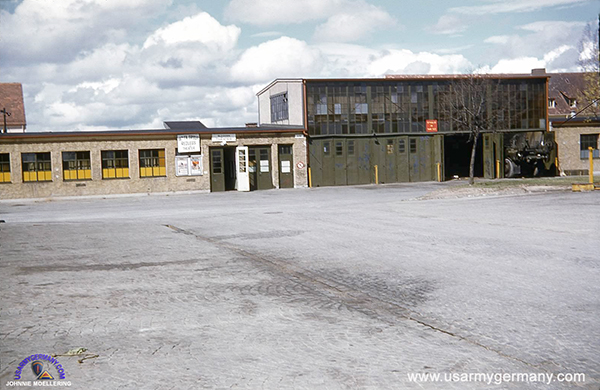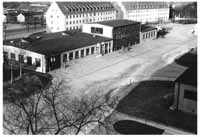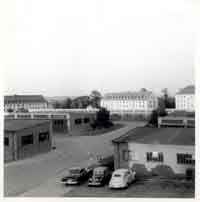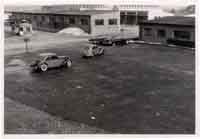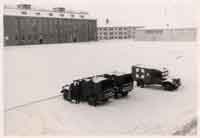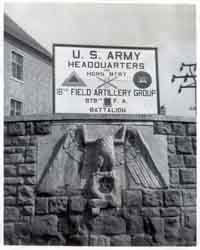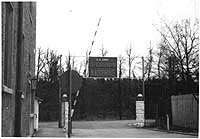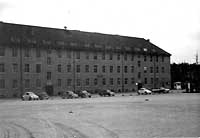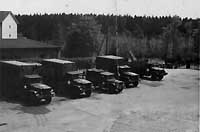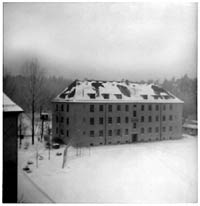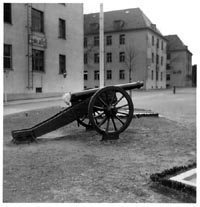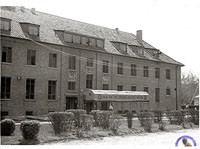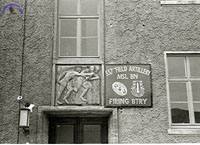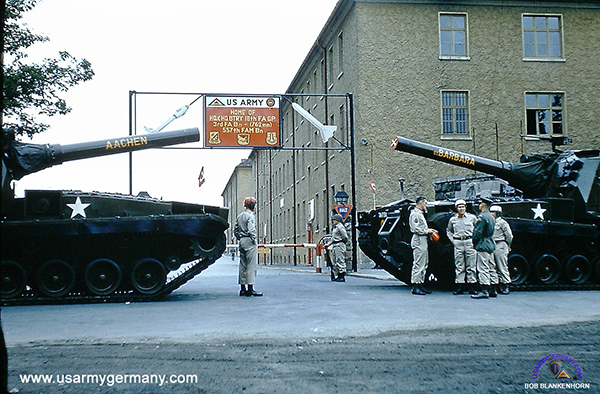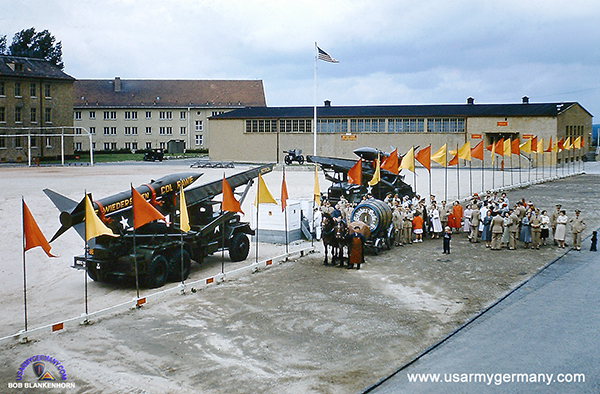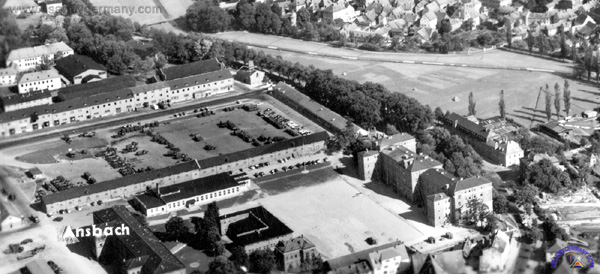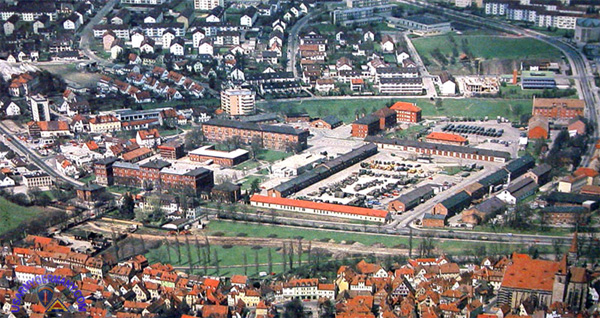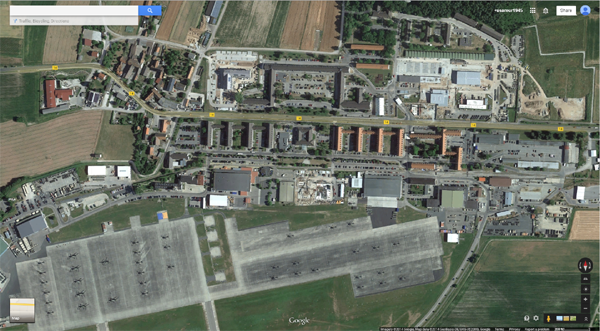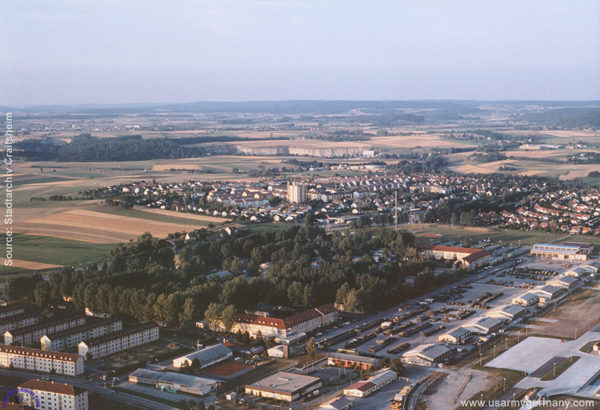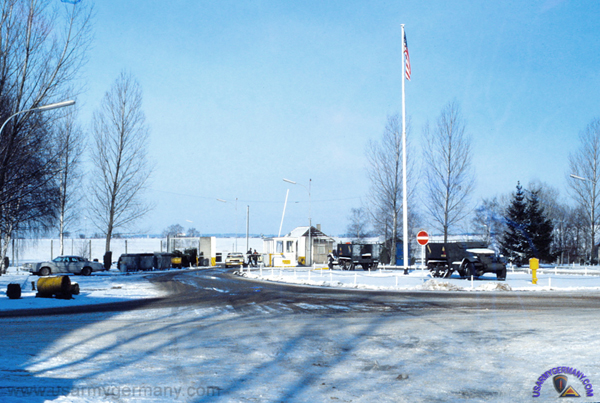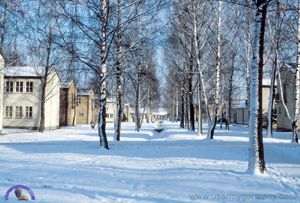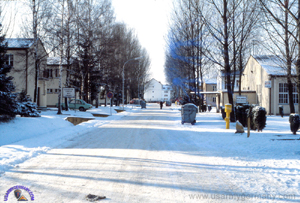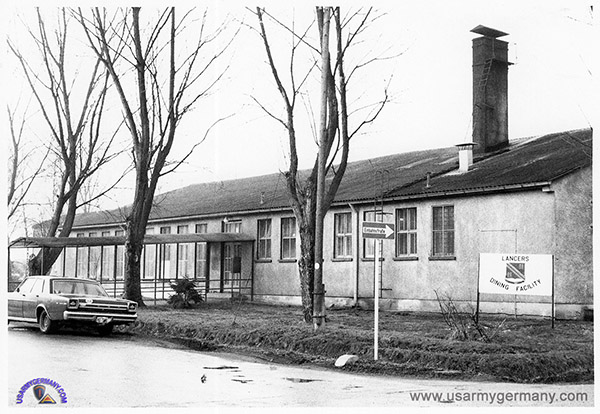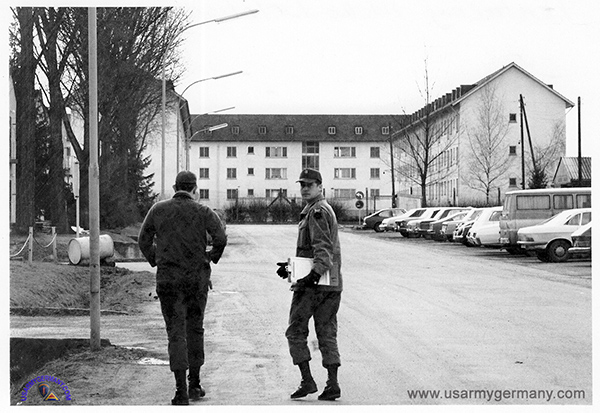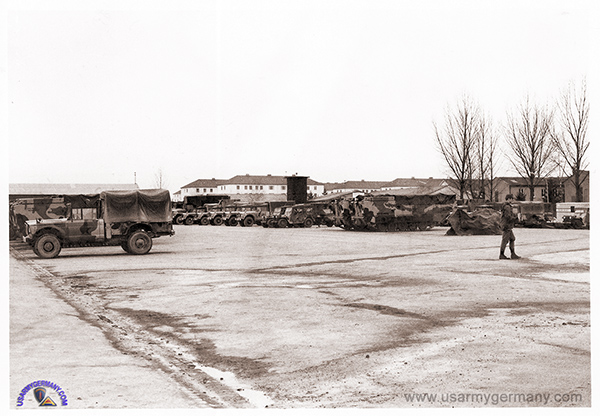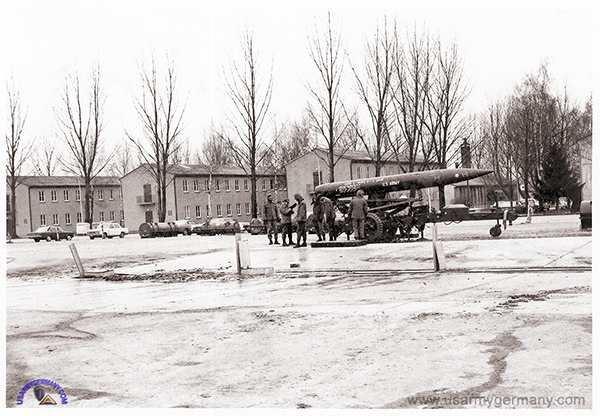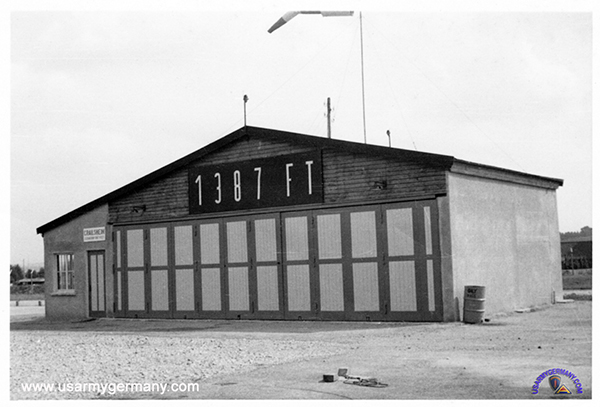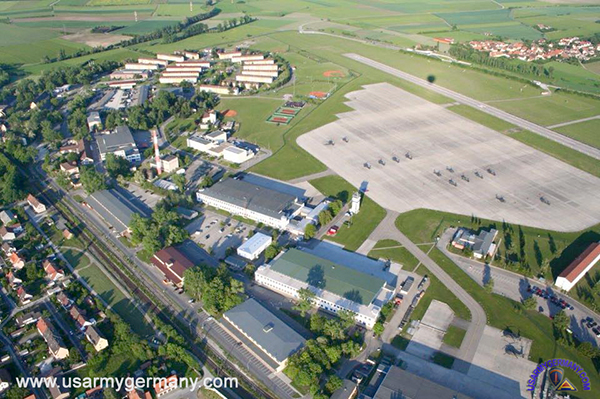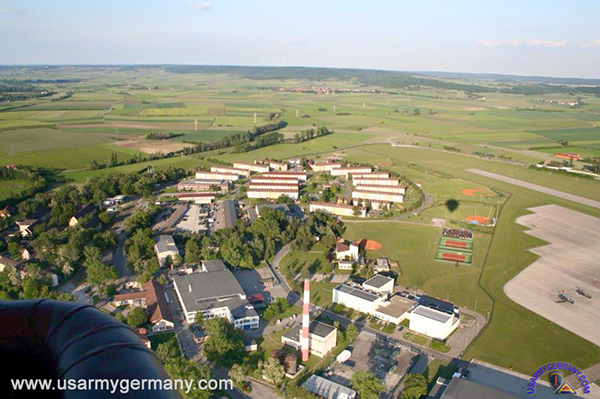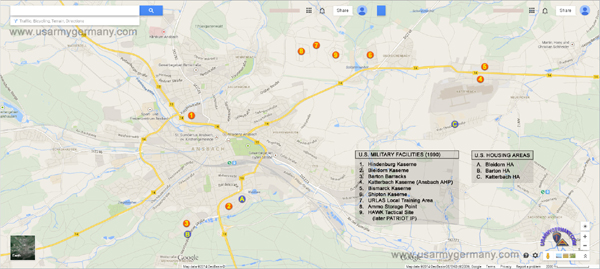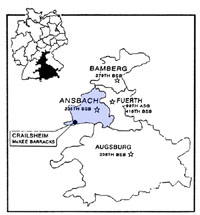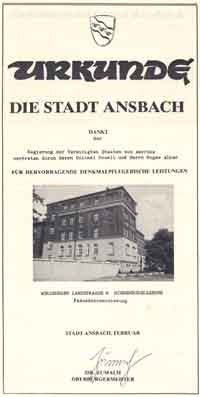Click here to open 'USArmyGermany' frameset
SHIPTON KASERNE |
||
| MAPS |
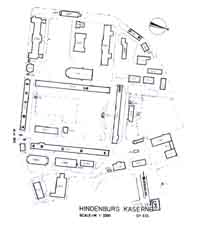 1. Hindenburg Kaserne, 1982 |
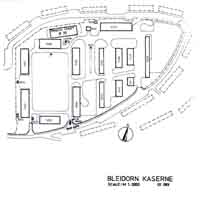 2. Bleidorn Kaserne, 1982 |
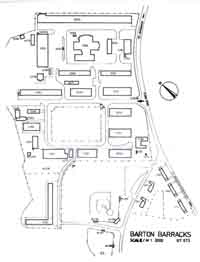 3. Barton Barracks, 1982 |
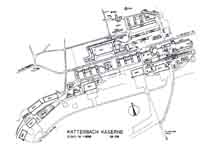 4. Katterbach Kaserne, 1982 annotated copy |
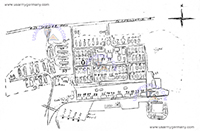 5. McKee Barracks, 1973 |
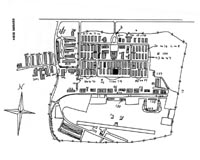 6. McKee Barracks, early 1980s |
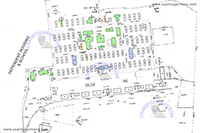 8. McKee Barracks, 1974 |
|
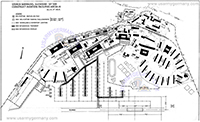 9. Storck Barracks, 1979 |
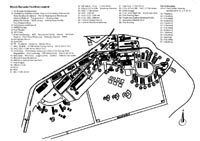 10. Storck Barracks, early 1980s |
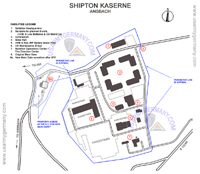 11. Shipton Kaserne, 1990 |
| 1960 Topographical map (Landesvermessungsamt Baden-Württemberg, L6926 / 1:50 000) of the Crailsheim area. |
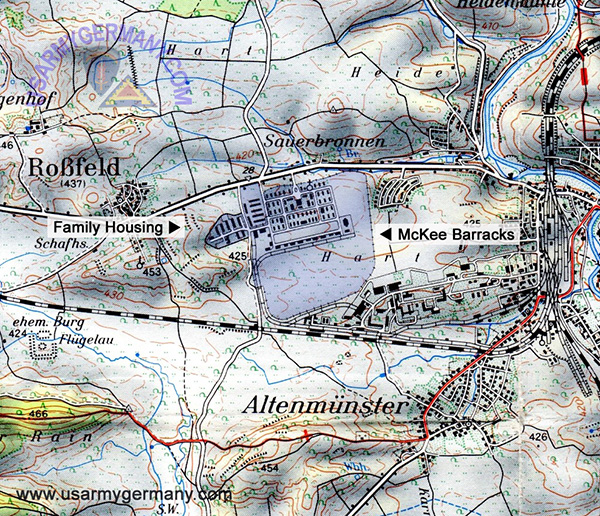
| 1970s Topographical map of Ansbach and surrounding area. Probably around the 1970s. Legend: 1. Hindenburg Kaserne 2. Barton Barracks 3. Bleidorn Kaserne 4. Bleidorn Family Housing 5. Ansbach Army Heliport 6. Bismarck Kaserne 7. Urlas Training Area Click on the thumbnail to view a larger format of the same map. |
 |
|
||||
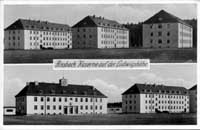 A. Kaserne auf der Ludwigshöhe |
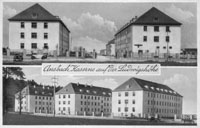 B. Kaserne auf der Ludwigshöhe |
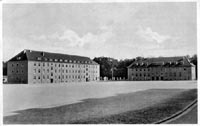 C. Bleidorn Kaserne |
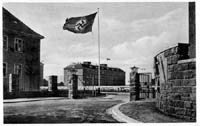 D. Bleidorn Kaserne |
|
|
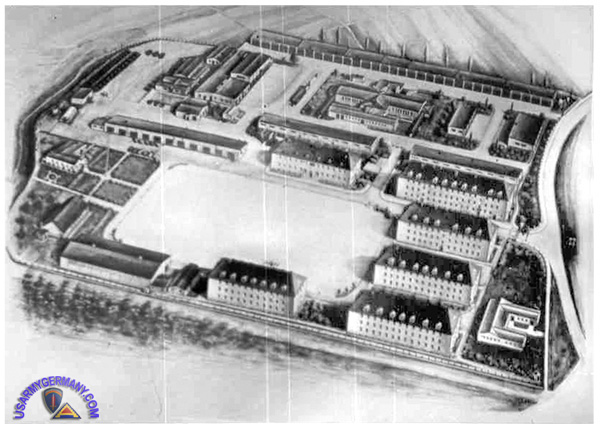 Barton Barracks, early 1950s (Neil Coy) |
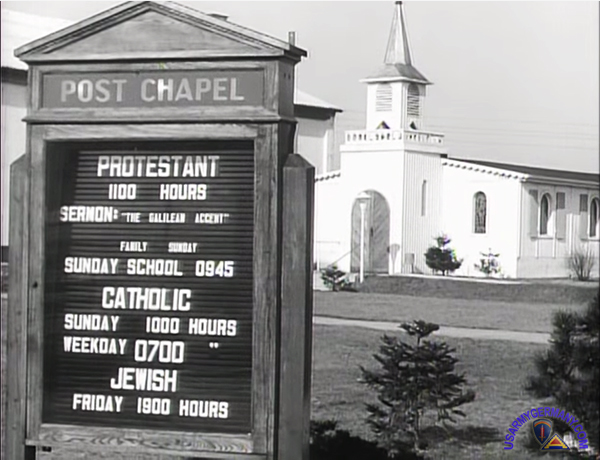 Post Chapel, Barton Barracks, early 1950s (USAREUR Technical Schools, Big Picture) |
|
|
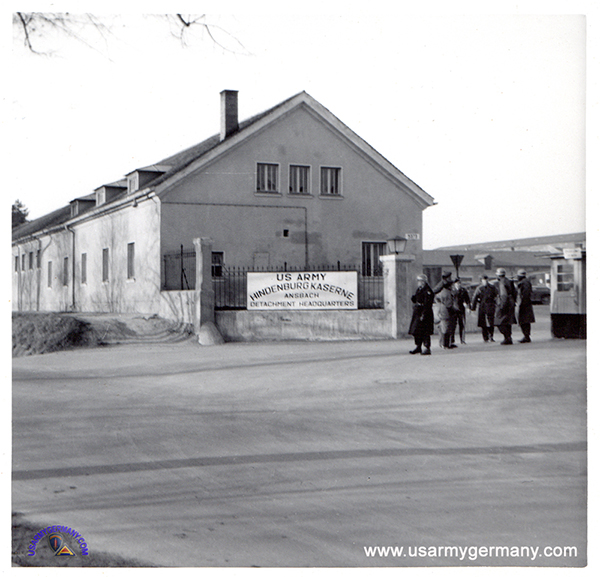 Main gate of Hindenburg Kaserne, 1953 (Webmaster's collection) |
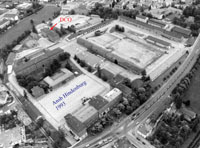 1. Hindenburg Ksn, 1993 |
||||
|
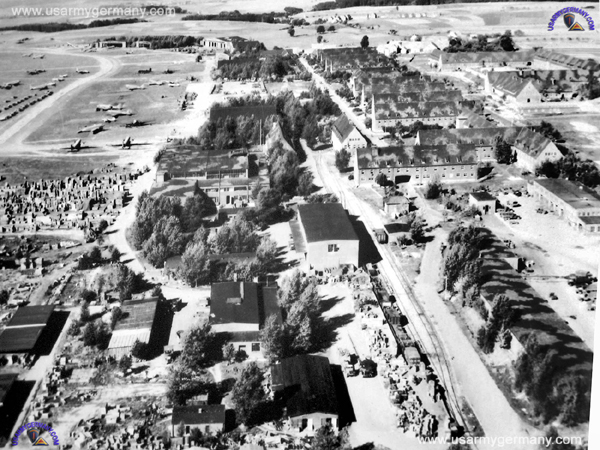 Aerial photo of Ansbach Air Depot at Katterbach, 1946 |
|
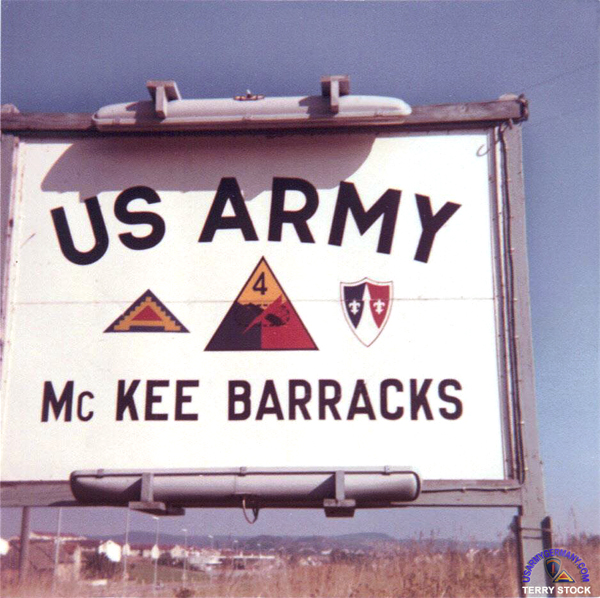 Installation sign for McKee Barracks at the main gate, c. 1968 (Terry Stock) |
|
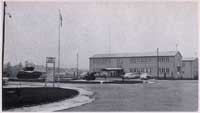 1. McKee Barracks, around 1958 |
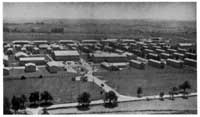 2. McKee Barracks, around 1960 |
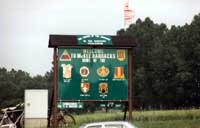 3. Sign at entrance to McKee Bks, late 1980s |
|
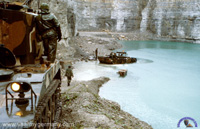 4. Quarry at Tiefenbach |
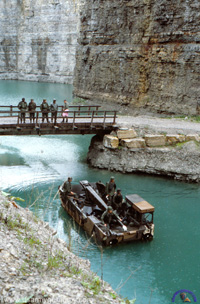 5. Quarry at Tiefenbach |
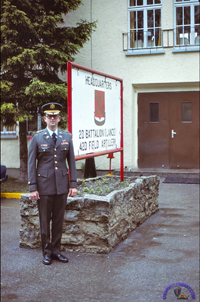 6. HQ Bldg, 2nd Bn, 42nd FA |
|
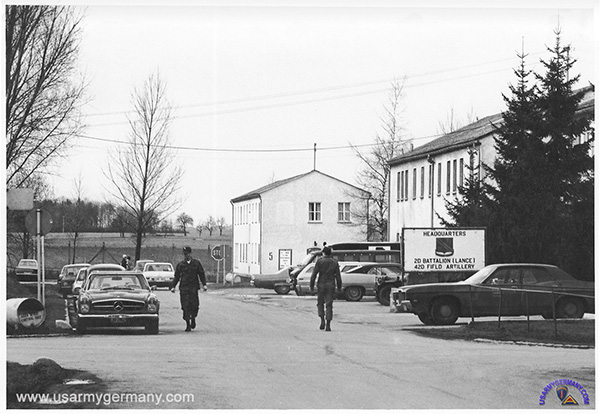 In front of Hq Building, 2/42nd FA at McKee Barracks, c. 1974 (Nifft Shea) (Click here for more of Shea's great pics on Flickr) |
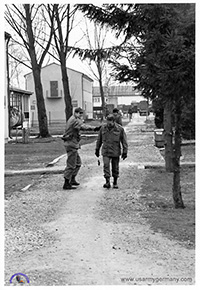 7. Motor pool in background |
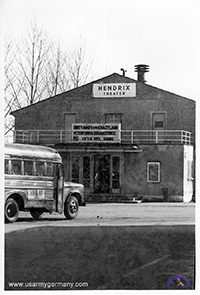 8. Hendrix Theater |
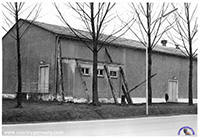 9. Hendrix Theater, side view |
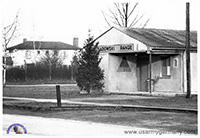 10. Sadowski Range |
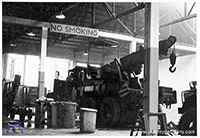 11. Maintenance shop |
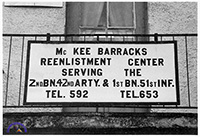 12. Crailsheim Reenlistment Office |
||
|
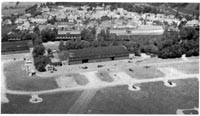 1. Illesheim Airfield, around 1960 |
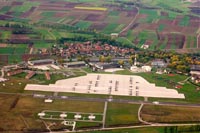 2. Illesheim Airfield, around 2000 |
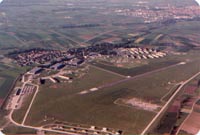 3. Illesheim Airfield, 1970 Click here to supersize |
|
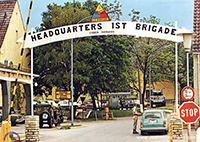 4. Storck Bks, 1968 |
|||
(Source: Email from Stafford Maheu)
Thanks for your excellent site and all that you do to preserve our Cold War experiences in Germany. I saw that you had posted a map entitled U.S. Military Installations in/around Ansbach - 1990 on 31 May, and were looking for other information. Your map is accurate with what I believe is one exception. I think that #8 and #9 should be swapped. The ADA Initial Ready Position (IRP) site was nearer to Shipton Kaserne than the ASP. (Webmaster note: the two mislabeled locations have now been corrected.)
I was stationed at Shipton from Nov 1987 to April 1991 and had arrived as part of a new PATRIOT battalion (6-43 ADA) which had been activated at Ft Bliss, TX to replace 2-57 ADA (Hawk) in Ansbach. The battalion Fire Direction Center was on Shipton with the rest of HHB and an organic DS Maintenance Company. There were three line batteries of which two were positioned on IRPs for 180 day periods. The third line battery was in a 90-day maintenance cycle. When the maintenance cycle completed it would replace the longer serving battery at an IRP. While in maintenance cycle the battery's eight PATRIOT missile launchers remained uploaded and were stored at the Central Missile Storage Area (CMSA). The CMSA for 6-43 ADA was at 49º 25' 55.02"N, 10º 24' 09.38"E. That's another minor facility for the Ansbach community. The battalion's second IRP was near the CMSA at 49º 26' 18.44"N, 10º 23' 56.37"E.
Both IRPs had been converted from Hawk configuration to support PATRIOT equipment. When I was stationed later in Germany (1999-2002); the PATRIOT battalion was still there (re-flagged as 6-52 ADA), but the missiles were gone. As such the CMSA, was being utilized by the Ansbach community as to store government housing furniture. The battalion has since departed Germany with the Shipton IRP recently becoming the new site of the Ansbach PX facilities.
Hope that this helps.
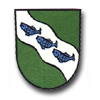
Ansbach is located in the northern part of Bavaria, approximately 117 miles southeast of Frankfurt and 26 miles southwest of Nuernberg. Community Commander for Ansbach was the Commanding General, 1st Armored Division. In 1975, Ansbach Military Community consisted of installations in and around the city of Ansbach and the sub-communities of Illesheim and Crailsheim. Geographic Locations identified as part of Ansbach MILCOM in USAREUR Reg 10-20, 14 Dec 1978 (1):
(1) The list of remote sites associated with Ansbach MILCOM in the 1978 Reg was incomplete. Some of the missings sites: URLAS local training area (also a tactical defense site of a HAWK air defense battery) and Oberdachstetten local training area. There were probably others. Additional information and details would be appreciated! Contact the webmaster. On 1 October 1991, under the Community Command Plan, USMCA Ansbach was reorganized and redesignated as the 235th Base Support Battalion and attached to the concurrently activated 99th Area Support Group in Nuernberg. Crailsheim sub-community became an Area Support Team under the 235th BSB.
|
|
Source: Ansbach Community Bridge (Ansbach MILCOM newspaper), October 6 1982
| Kasernes have
long history NOTE: In July, the Ansbach Community Bridge gave you a brief view of the history of the kasernes in the Ansbach area. In the next four issues we will look at the history of the kasernes in the Ansbach Military Community. In this issue, we will see how Bleidorn evolved from being a minor support kaserne for Rommel's 7th Panzer Division into the modern Artillery kaserne it now is: The Bleidorn Kaserne was completed in 1936. Situated on the south ridge overlooking Ansbach, Bleidorn has one of the most scenic locations in the area and provides a beautiful view of the city and up the valley toward Wuerzburg. The Kaserne was first occupied in October 1936, by the 17th Reconnaissance Group, (Panzeraufklaerungsbataillon), an element of the 7th Panzer Division, General Rommel's first major command. The group was organized with four companies and consisted of approximately 500 personnel. The Headquarters and Service Company consisted of the command elements and support functions. Among those was the signal section which was responsible for all communications. The 17th Panzeraufklaerungsbataillon remained in Bleidorn until the beginning of the war in September 1939 when the Battalion was fully amalgamated with the 7th Panzer and left Ansbach. At the beginning of the war, the first of a long series of tube artillery units moved into the Kaserne. An artillery unit larger than a battery, but smaller than a battalion with the designation 103 and armed with 75 mm guns occupied a portion of the Kaserne during 1941 and 1942. The 53rd Artillery Battalion was a unit similar to today's Advanced Individual Training units. The cadre of the unit consisted of wounded combat veterans who were no longer physically fit for combat. New soldiers were trained on 100 mm guns and 150 mm Howitzers. This unit remained until the end of the war in 1945. After the end of the hostilities, the kaserne was largely used by civilian agencies. In 1945 and 1946, it was a refugee repatriation camp which dealt primarily with homeless Jews. It later processed displaced persons from many of the eastern European countries. During this period the buildings on the east side of the quadrangle were used as displaced persons hospitals while the buildings on the west side of the quadrangle were vacant. The United States Army moved into Bleidorn in the end of 1949. The first US unit to occupy the post was the 539th Signal Construction Company with a German Labor Service Signal Construction Company. Under the direction of the 539th, the German Labor Service company underwent rapid expansion and soon grew to battalion size. Its increased size and a new mission made the Signal Construction units too big, and in 1951 they left Bleidorn. In the early 1950's, the headquarters of the 18th Field Artillery Group moved into Bleidorn, and was accompanied by one of the battalions of the group. The battalion was a 155 mm Field Gun Battalion which was redesigned at the 70th Armored Field Artillery Battalion in 1955, and remained until the early 1960's. In the early 1960's, the Kaserne was the home of the 2d Bn, 40th Artillery, a Corporal Missile Battalion. This unit remained in the Kaserne until late 1963 when they were deactivated. In late 1963, the billets were remodeled and in early 1964, a Sergeant missile battalion moved in and remained until 1966. In mid-1966, the 2d Bn, 28th Artillery, a 175 mm Gun Battalion stationed at Hindenburg Kaserne moved to Bleidorn and has remained as the major tenant of the Kaserne to the present time. In addition to the 28th Field Artillery several smaller units have occupied the Kaserne since 1966. Other tenant units have included 501st Military Police Company and elements of the 793d Military Police Company. The kaserne has a long and distinguished history. In the next issue, we'll look at Storck Barracks (Illesheim) and Oberdachstetten which constituted a major German armaments production center and range facility. (As far as I can determine, this article was never published.) |
Source: Ansbach Community Bridge (Ansbach MILCOM newspaper), July 21 1982
| Another kaserne
at Katterbach, was built in 1935. Katterbach was then (and still is)
a typical farmers' village, although it was annexed to the city of
Anbach in 1972. In the fall of 1934, the German Government started buying real-estate in the community to build an airfield for the German Air Force. Construction started in 1935, south of Highway 14 and simultaneously the construction of dependent housing area commenced in Obereichenbach. In 1938 the whole project of the Katterbach airfield was completed and Bomber Wing 53 moved in. They flew missions to Spain during the Civil War and the Wing received the name "Legion Condor". Headquarters of Bomber Wing 53 remained in Katterbach throughout the whole war. During World War II, Bomber Wing 53 flew missions in Poland, France, England, and Russia. The last mission was flown on January 5, 1945 to London. After the war, units from the 1st US (Infantry) Division moved into both north and south side of Katterbach, but stayed there for less than a year. EES (European Exchange System) moved in then and Katterbach South developed into one of the biggest depots in Europe. The North Kaserne was utilized by Labor Service until 1954, at which time a Bundeswehr Signal Battalion moved in. EES depot Katterbach folded up in 1966 and gradually Army Aviation units started utilizing some of the structures. In August 1968, the North Kaserne was vacated by the Bundeswehr and after rehabilitation the 1st Battalion, 37th Armor was moved from Hindenburg Kaserne, Ansbach to North Kaserne, Katterbach in 1969. |
There was a pedestrian tunnel from the airfield side which went under the road to the little base across the street. There was a bunker on that little base for the German pilots and officers when the Allied airplanes bombed.
In the building I was assigned to there was a boiler room only the German engineers had access to. Since I was a near native German speaker I was often called to escort them.
After about a year of doing this they invited me into one of the rooms in the basement only they had access to as they alone had keys to the door. They said they had a surprise for me since I had German ancestors. One the wall was a painting of the earth with German bomber planes and and the phrase, “Die Welt gehört Uns.“
When I asked what unit this had been they told me the Condor Legion, which had supported Franco prior to WWII.
Webmaster note: The Legion Condor (or "Legion Condor" in German) was an air force unit made up of Luftwaffe personnel from Nazi Germany’s Wehrmacht which served with the Nationalist faction during the Spanish Civil War in the second half of the 1930s.
Source: Ansbach Community Bridge (Ansbach MILCOM newspaper), July 24 1986
Many of the long, one-story structures, such as those that house the Army Post Office and the Vehicle Inspection Station, were stables for the horses of the 17th Cavalry Regiment. The brick structure that now houses the JAG Office was once the Regimental Commander's Quarters. The building is among the oldest on post, and is under consideration for inclusion on the list of historical sites, Powell said. Powell said that all exterior work done in the city, including Hindenburg Kaseme, must be approved by the City Planner before the actual work begins. More than a dozen Ansbach residences and businesses were honored at the ceremony for facade restoration work. Each representative received a photo-embelished certificate acknowledging their work, and a copy of a history of Ansbach from Lord Mayor Dr. Ernst-Guenther Zumach. What is today known as Hindenburg Kaserne has a long and distinguished history stretching back to the time of Magrave Wilhelm Friedrich. Following are some of the key dates in the kaseme's history. |
| • 1722 | Margrave Wilhelm Friedrich began construction of a kaserne for an infantry regiment. It was located at the present site of Hindenburg Kaserne. | |
| • 1724 | Margravine Christine Charlotte completed the kaserne, including a chapel and military cemetery. | |
| • 1842 | A Chevauleger Regiment moved in and built the necessary stables. (In 1806 Ansbach had become part of Bavaria). | |
| • 1863 | The Second Royal Bavarian Uhlan Regiment Koenig (King) was activated and moved into the kaserne. | |
| • 1880 | The military cemetery was leveled. | |
| • 1901 | The old kaserne was torn down, and the chapel destroyed. | |
| • 1921 | After World War I, the Second and Third Squadron of Cavalry Regiment 17 moved into the rebuilt kaserne. | |
| • 1935 | The kaserne was named Hindenburg Kaserne. The cavalry was replaced by the 53rd Artillery Regiment, a horse drawn howitzer unit. During World War II the kaserne housed an infantry battalion. Immediately after the war, the kaserne was used as a refugee camp for Lithuanians, Estonians and Latvians as well as for a few Polish refugees. | |
| • 1951 | The sub-post Ansbach moved into Hindenburg Kaserne which had been vacated by the refugees and partially refurbished. A Military Police Station, dispensary and other facilities were established. It took several years before the first unit, a Chaparral Missile Battalion, part of the 18th Field Artillery with headquarters at Bleidorn, moved into Hindenburg. In the middle 1960s the Artillery battalion moved out to make room for 1-37th Armor, a first step in moving the 4th Armored Division from Goeppingen to Ansbach. | |
| • Late 1960s | 1-37 Armor moved to Katterbach's Bismarck Kaserne, where a Bundeswehr signal battalion had been stationed, and after refurbishment of the post, 4th Armored Division, (later designated the 1st Armored Division), moved into Hindenburg Kaserne in 1971. | |
Source: Crailsheim ACS Welcome Packet, early 1980s
McKee Barracks, located midway between Nürnberg (Nuremberg) and Stuttgart on Route 14, was named after Major John L. McKee, Jr. of the 901st Field Artillery Battalion. Major McKee was killed in 1945, while engaged in a spotter flight over Trebnitz, Germany. McKee Barracks is located one mile east of Crailsheim, a junction point for highway and railway traffic crisscrossing central Germany. During World War II, the area now known as McKee Barracks was an aviation and pilot training school for the Gernan Luftwaffe. A portion of this field was destroyed in the Allied bombing in March, 1945, and during the Four Day Battle in April, 1945 when elements of the 10th Arnored Division occupied Crailsheim. Two of the hangars are still standing at the rear of the post air strip. American troops, after fierce fighting, occupied Crailsheim on 6 April, 1945, withdrew on 10 April and reoccupied the area on 20 April, 1945. McKee Barracks, plus five four-story dependent buildings, were built in 1951. On December 15, 1952, the Recreation Center was first opened and in 1953, the remaining dependent quarters were completed. The gym was completed in 1954, followed by construction of the Tank Park Hardstand in 1957 and the washracks in 1958. There are a total of 107 permanent and 19 temporary buildings. This includes space for approximately 2,000 troops and 309 families. Normal support facilities are available. |
4th Missile Battalion, 28th Artillery - an interesting webpage hosted by the Lacrosse Battalion's Reunion Group.
